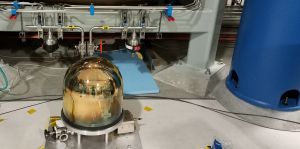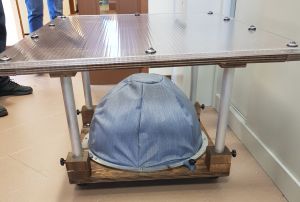Difference between revisions of "Environmental Noise"
(→Atmospheric) |
(→Atmospheric) |
||
| Line 38: | Line 38: | ||
== Atmospheric == | == Atmospheric == | ||
| + | [[File:Windshield_EGO.jpg|thumb|Microphone windshield designed for outdoor deployment by EGO scientists.]] | ||
| − | |||
[[https://journals.aps.org/prd/abstract/10.1103/PhysRevD.97.062003 Modeling of acoustic NN in ground-based and underground GW detectors (2018)]] | [[https://journals.aps.org/prd/abstract/10.1103/PhysRevD.97.062003 Modeling of acoustic NN in ground-based and underground GW detectors (2018)]] | ||
Revision as of 12:29, 18 April 2020
Contents
Newtonian Noise
Terrestrial gravity fluctuations due to environmental fields and moving or vibrating objects poses an important source of environmental noise in gravitational-wave (GW) detectors. This noise is known as Newtonian noise (NN) or gravity-gradient noise. Unless associated with objects, NN has a steeply falling spectrum, which makes it relevant especially at low frequencies (mainly below 30 Hz).
Current research activities are on the modeling of NN, by analytic studies as well as numerical simulations, and on the development of noise-mitigation methods, especially coherent noise cancellation.
[Terrestrial Gravity Fluctuations (2019)]
Seismic
[Correlation studies of oceanic microseisms with a 3D array at the former Homestake mine (2019)]
Seismic noise is mostly generated near the surface and seismic motion underground is more stable and lower. Newtonian Noise (NN) is expected to be approximately two orders of magnitude less underground.
Body-wave NN cancellation
In underground detectors, we can suppress Newtonian Noise from surface waves very well, but we have still to deal with NN from body waves.
We need then to understand if we can actually suppress this kind of noise. The basic idea is to cancel it out from the data by using a Wiener filter. This comprises the placement of some seismic sensors which should record the seismic field in order to reconstruct the NN affecting the test mass. Instead of placing real seismometers, we modeled a simple isotropic and homogeneous seismic field that surrounds the test mass of the detector and that is composed only by body waves. With this model we found that with already 13 seismic sensors set in an optimal configuration we can reduce the NN by a factor 10, while we can still reach a factor 3 of reduction even with a degraded sensor configuration.
[Body-wave NN cancellation for ET (2019)]
Topographic scattering problem
The efficiency of a Wiener filtering cancellation scheme is determined by a two-point spatial correlation. Correlation can be significantly reduced due to scattering and a seismic array consisting of a large number of seismometers needs to be deployed. The rough topography can be the source of strong seismic waves scattering. The problem of topographic scattering is partly solved by the underground construction of ET, but since scattered surface waves are not generally of Rayleigh type, they can generate displacement deeper than Rayleigh waves.
Advanced Virgo +
The design of a NN cancellation system requires the modeling of correlations between environmental sensors and test-mass acceleration. Since analytic models are always too simple to represent a realistic seismic field, it is necessary to construct models based on seismic observations, and, if available, on correlation measurements between seismometers and test-mass acceleration. Such models are called surrogate models, and we use them to predict the NN spectrum and to optimize the designs of NN cancellation systems.
The recipe for achieving this is to take seismic data from which we can retrieve a prediction of the two-point spatial correlations of the seismic field via a regression model and then using this model to estimate the NN acting on the test mass due to the passing seismic waves. We have applied this technique to design a NN cancellation system for Advanced Virgo +, and plan to extend it to underground detectors like ET in the future.
[Array analysis at Virgo (2019)]
[Virgo NN reduction by recess at Virgo (2020)]
LIGO
[Array analyses at LIGO Hanford (2018)]
Atmospheric
[Modeling of acoustic NN in ground-based and underground GW detectors (2018)]
Gravity fluctuations can be associated with fields of pressure, temperature, or humidity. Atmospheric gravity perturbations are expected to be the dominant contribution to ambient NN below 1 Hz, and can still be significant at higher frequencies. The two most important questions to answer are how strongly atmospheric NN is suppressed with depth and transmission of atmospheric disturbances in the form of seismic waves into the ground.
Advanced Virgo +
[Empirical mode decomposition for acoustic-transient analysis (2019)]
Magnetic noise
[Measurement and global correlation of Schumann resonances (2018)]

